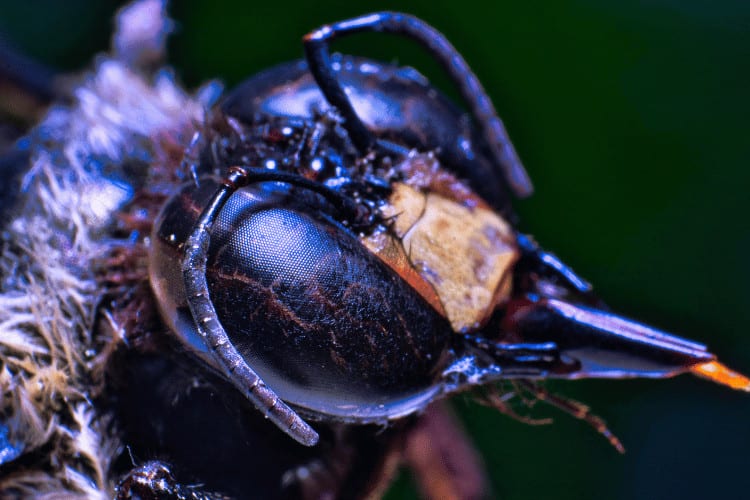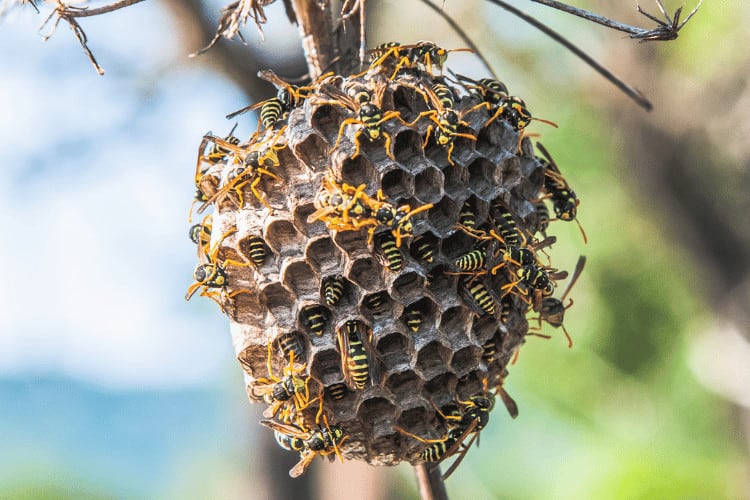Carpenter Bees Fighting: Causes and Prevention
Carpenter bees, known for their affinity for wood and wooden structures, can sometimes engage in territorial scuffles that might surprise you.
Knowing the reasons behind this pattern, along with effective ways to prevent it from happening, can help keep things serene in your backyard.
So, let’s grab our beekeeping gear, don our curiosity hats, and explore the captivating world of carpenter bee fighting!
Understanding Carpenter Bee Fights

Ah, the carpenter bee; nature’s skilled architect!
These aren’t your average bees. Carpenter bees, known scientifically as Xylocopa, are larger and stouter than your common honeybees.
They’re nifty woodworkers, with a penchant for wood surfaces, often preferring soft, unfinished, unstained, and untreated wood to create their intricate carpenter bee nests.
You may have seen them hovering around your wooden structures, like a fascia board, outdoor furniture, and even your favorite garden benches. Their thing is creating tunnels in wood.
Here’s the thing, though; not all adult bees are on friendly terms! Sometimes, these large bees can get into what seems like carpenter bee fights!
The fights often involve male carpenter bees guarding their territories against intruders, typically other male bees looking to establish their own nests.
A female carpenter bee will also fight for its nest and eggs. As a matter of fact, fights between female bees tend to be more intense than ones between males.
The Buzz About Territory
Territorial behavior is not uncommon in the world of social insects, and carpenter bees are no exception.
These tussles can occur when multiple male bees claim the same wooden area as their own, resulting in clashes that are as impressive as they are intriguing.
These aerial scuffles can involve buzzing, darting movements, and high-speed chases through the air, all in the name of defending one’s claimed turf.
They’re quite a spectacle, in my experience.
The Main Battle Tactics
So, how do these carpenter bee fights really play out?
Picture this: two male carpenter bees spot each other near their preferred wooden surface. The buzzing intensifies as they engage in rapid, zigzagging flights.
It’s like a high-stakes game of bee chase through the air!
These contests are more about showcasing agility and dominance rather than causing harm, as carpenter bees lack stingers in males.
Tips for Preventing Carpenter Bee Fights
Are you tired of your carpenter bees always fighting for dominance? Here are a few ways to put an end to their skirmishes, or at least reduce them:
1. Hive Placement Planning
When setting up bee hives, choose locations wisely.
Space out the hives to reduce congestion and minimize the chances of bees from different hives coming into contact.
Having adequate space allows bees to have their own territories, reducing conflicts.
2. Hive Customization
Give each hive a distinct entrance design or color.
This helps returning bees identify their hive easily, reducing the likelihood of mistaken entry into another hive.
Unique hive entrances discourage foreign bees from entering and provoking fights.
3. Hive Rotation

Periodically rotate the positions of your hives. This will help prevent bees from becoming too accustomed to their surroundings and potentially developing aggressive territorial behaviors.
Changing the hive locations can disrupt established territories and reduce conflicts.
4. Regular Inspection and Maintenance
Frequent hive inspections allow beekeepers to identify signs of stress or overcrowding.
By addressing these issues promptly, beekeepers can prevent situations that might lead to fighting, such as resource shortages or aggressive competition.
5. Providing Adequate Resources
Ensure each hive has enough food and water sources.
Adequate pollen, nectar, and water availability reduces competition among bees for these essential resources.
Well-fed bees are generally more peaceful and less likely to engage in territorial disputes.
6. Introduce Barrier Plants
Plant bee-friendly barrier plants around the hive entrances. These plants can act as natural borders, visually separating hive territories.
Also, they can offer extra forage opportunities, diverting bees’ attention away from potential conflicts.
7. Implement Dividers
Consider using removable dividers within the hive to create separate compartments. This prevents direct contact between bee groups and minimizes fights over space or resources.
Dividers can be particularly useful during the expansion of the hive.
8. Monitor Behavior Patterns
Keep a close watch on bee behavior and body language. If you notice increased aggression or territorial disputes, take proactive measures to address the underlying causes.
This could involve adjusting hive management techniques or introducing calming techniques.
9. Citrus Water

Here’s a neat trick that seasoned beekeepers often employ:
Carpenter bees have a distaste for the scent of citrus. So, by spraying a mixture of citrus water on your wooden structures and individual hives, you can deter the buzzing brawlers from doing battle or settling in.
It’s like placing a “No Trespassing” sign that only the bees can read!
10. Insecticidal Dust
As a last resort when things get a bit more serious, you can use insecticidal dust.
If carpenter bees have already made themselves at home and are causing significant damage, you might consider using insecticidal dusts. These powders are specifically designed to target these wood-boring pests.
However, keep in mind that such measures should be a last resort. After all, preserving the bee population is crucial for maintaining our ecosystems.
Wrapping Up
So, there you have it, beekeepers and future bee buddies!
Carpenter bee fights are not just a random spectacle; they’re a testament to the dedication and territorial instincts of these fascinating insects.
Next time you witness those aerial acrobatics, you’ll know that beneath the tussling wings lies a story of defense, territory, and a passion for prime wooden real estate.
Remember, keeping carpenter bees from fighting isn’t just about keeping your structures safe; it’s about coexisting harmoniously with these amazing creatures.
Implementing the above-discussed strategies not only protects your wooden investments but also contributes to the well-being of these essential pollinators.
Happy beekeeping!
